When the cosmos aligns for an event as rare as a solar eclipse, having the right technology stack is crucial to capturing the fleeting moment with precision and clarity. Given that the next opportunity won’t be until 2044, we decided that this was the moment to build the most StorageReview Eclipse Capture Rig possible, thanks in large part to our friends at OWC.
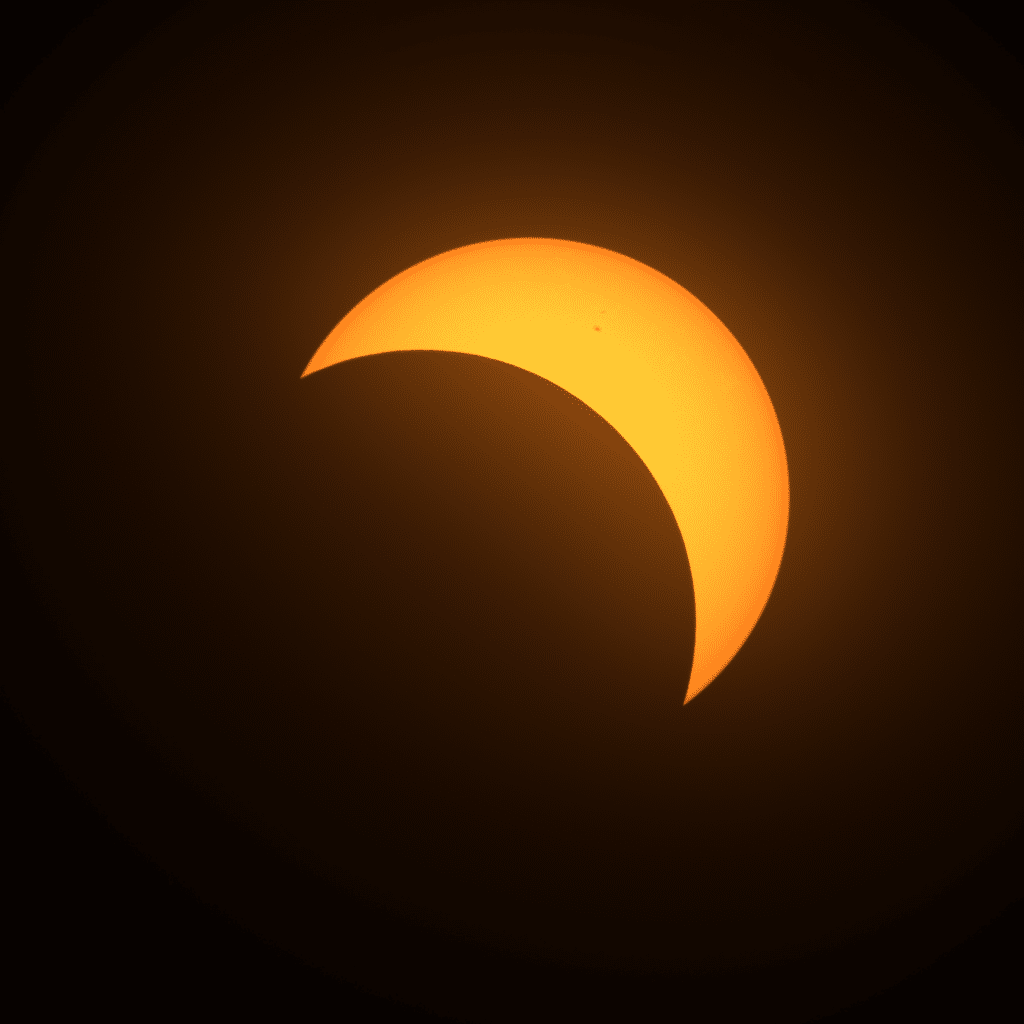
Software Synergy
Central to this cosmic dance is the Eclipse Orchestrator. At its core, it is the meticulous planner, predicting the eclipse timeline with down-to-the-second accuracy. Its strategic value lies in its ability to calculate the local circumstances of an eclipse, ensuring photographers and observers are at the right place at the precise time. The significance of positioning cannot be overstated—proximity to the centerline of the eclipse path can yield the most prolonged duration of totality, offering a longer window to capture the dramatic interactions between the Sun, Moon, and Earth.
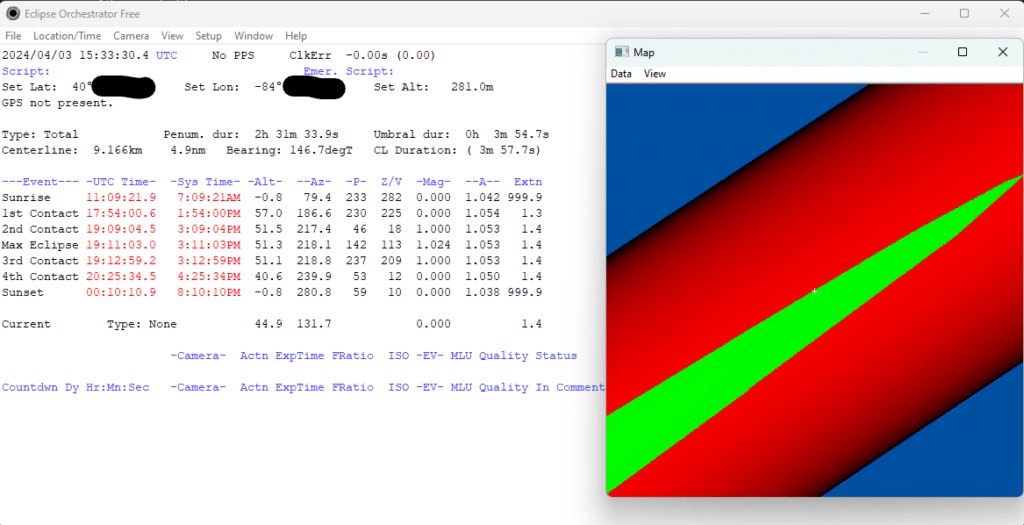
The Eclipse Orchestrator software is a comprehensive tool designed for solar eclipse chasers and photographers. It assists in planning and executing eclipse photography, providing precise timing and scripting capabilities to capture the event’s different phases. Here are the definitions from the American Astronomical Society:
- First contact (C1): The moment when the Moon takes its first tiny nibble out of the solar disk — the beginning of the partial phase of an eclipse.
- Second contact (C2): The instant when an eclipse’s total or annular phase begins. It is synonymous with the disappearance of the first diamond ring during a total eclipse. At second contact during a total solar eclipse, darkness suddenly falls (but only to the level of deep twilight).
- Third contact (C3): The instant when a solar eclipse’s total or annular phase ends. For a total eclipse, this is synonymous with the appearance of the second diamond ring. At third contact during a total solar eclipse, daylight suddenly returns.
- Fourth (last) contact (C4): The instant when the Moon no longer covers any part of the solar disk. This signals the conclusion of an eclipse’s partial phase.
The main window shows a log that records various details about an eclipse event. It includes timestamps for different stages, such as first contact, sunset, and last contact, with precise timings in UTC. It also lists the altitude and azimuth positions, the phase of the eclipse, and various other parameters. A countdown timer is also included to indicate the time to the next significant event or contact point.
The secondary pane on the right shows a colorful graph illustrating the eclipse path overlaid on the location indicated by the white cross.
- Locations with a longer umbral duration than your set location are shown in green (go here).
- Locations with a shorter umbral duration are shown in red (stay away).
- Locations with no totality are shown in light blue.
- Locations with no eclipse are shown in dark blue (not pictured).
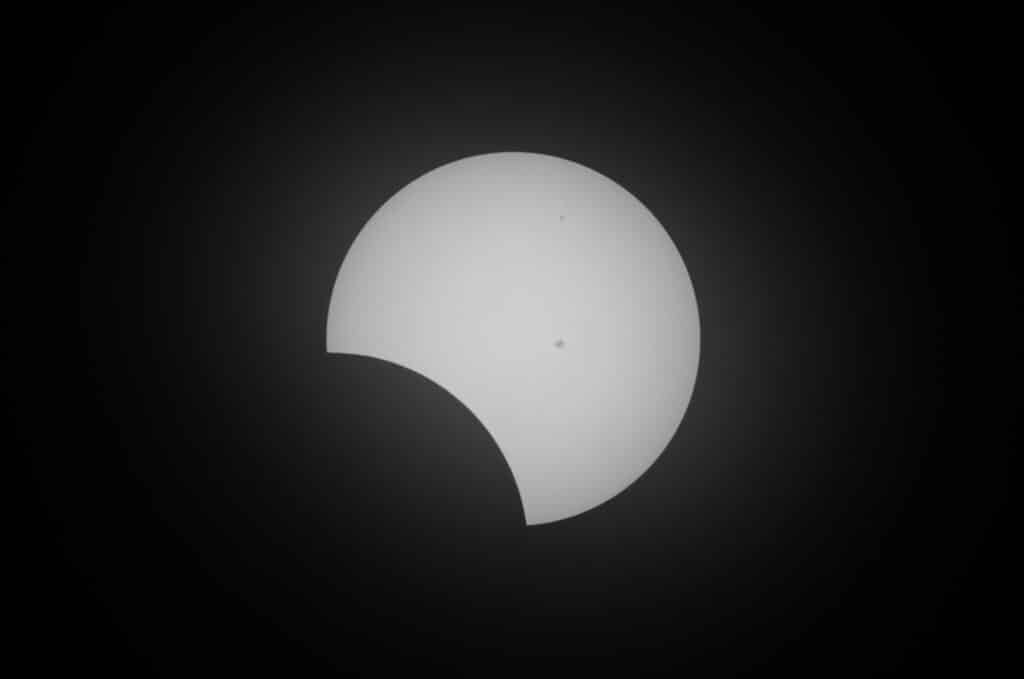
This tool is crucial for planning and executing a successful eclipse observation and photography session. Precise timing and scripting capabilities allow users to automate the photography process to capture images at optimal moments. The positioning data is also vital as it helps ensure that the observer is as close to the center of the eclipse path as possible, where the duration of totality is the longest, which is critical for capturing the entire event.
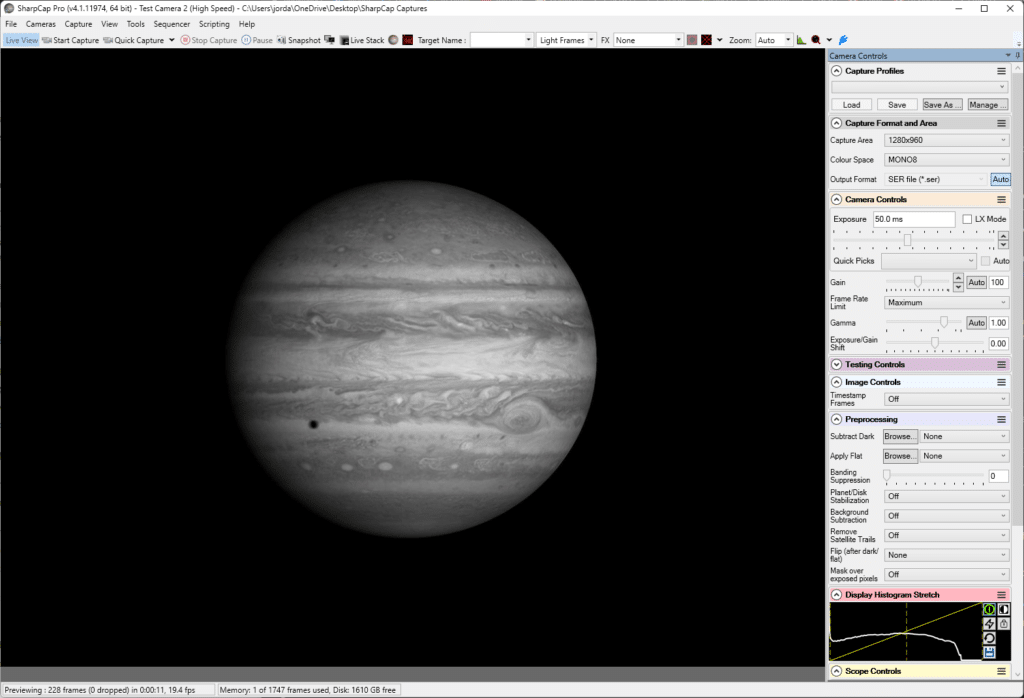
Complementing the meticulous planning is SharpCap. Beyond being just a camera controller, SharpCap is the automation maestro that commands the stage of celestial photography. Features like automation scripting allow capturing high-resolution images at predefined intervals. When merged with its telescope control and guiding capabilities, SharpCap ensures that the celestial subjects remain in focus, providing a crisp portrayal of the eclipse progression.
Hardware Precision
The backbone powering these applications is the Lenovo P16 Gen 1 Laptop, a high-performance computing beast capable of handling the extensive data throughput required for real-time image processing and storage.
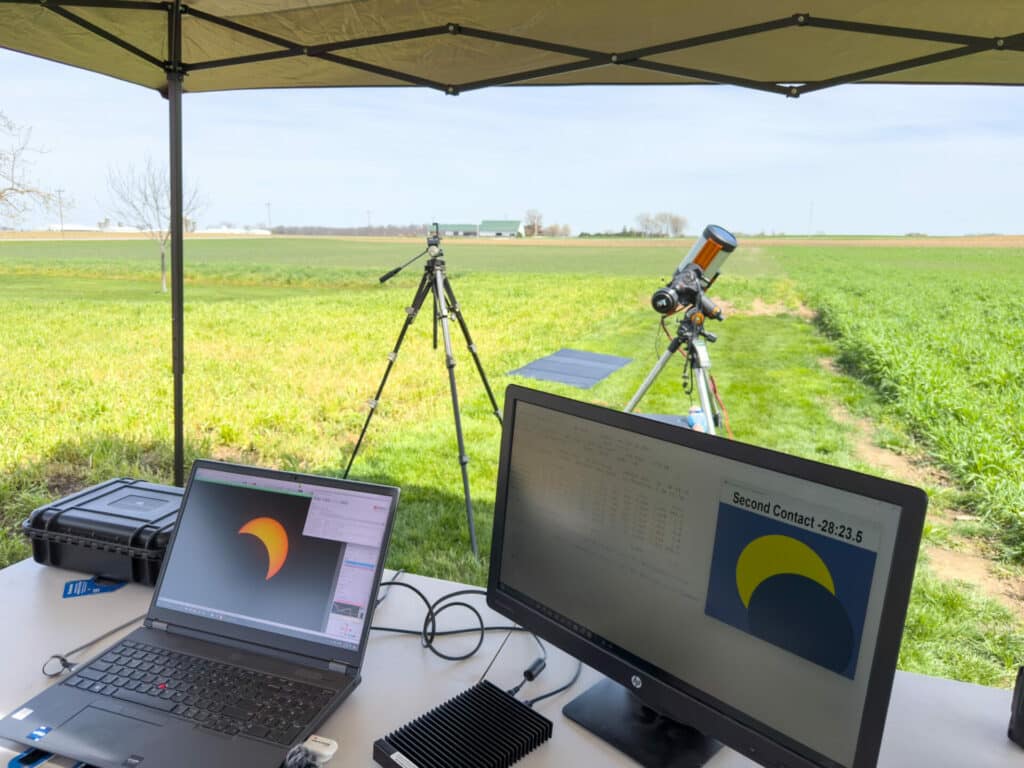
Specifications for our Lenovo ThinkPad P16 Gen 1 unit include:
- Windows 11 Pro
- 16-inch WQUXGA (3840×2400) screen
- Intel Core i9-12950HX processor
- NVIDIA RTX A5500 graphics card (16GB)
- 64GB DDR5-4800 RAM (2x32GB)
- 2TB Gen4 SSD
The eclipse is fleeting, but data is eternal. To capture as many frames as possible, we brought in the OWC ThunderBlade. This high-speed external storage is the digital vault where the celestial event’s data securely resides. Its rapid data transfer capabilities ensure that all information is saved without a hitch, allowing for seamless data management and post-event analysis.
OWC ThunderBlade
The OWC ThunderBlade stands as an impressive data storage solution. With speeds up to 2,949MB/s in RAID0, it’s no surprise that this device is highly regarded by professionals who demand efficiency and reliability, particularly in astrophotography and videography. This performance represents the difference between capturing an adequate image of an eclipse and an amazing one, with every solar prominence and coronal detail preserved.
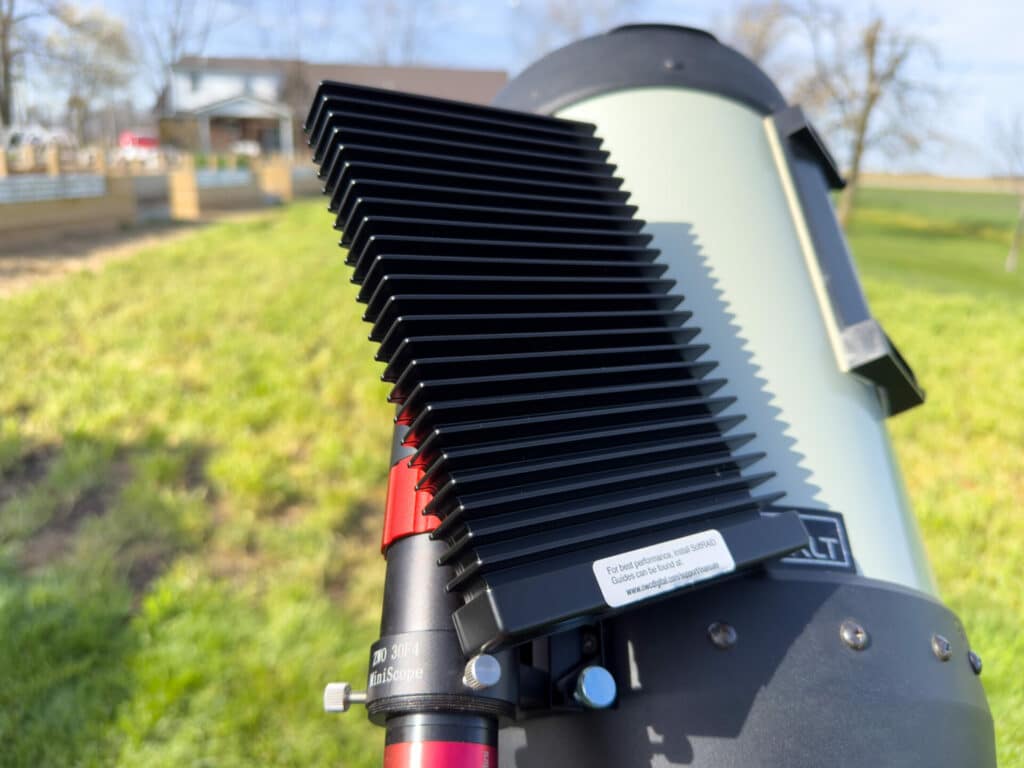
Durability and versatility are also at the core of ThunderBlade’s design, as it is both a reliable workhorse and a safeguard for important astronomical data. With a height of 1.1 in, length of 7.6 in, and width of 4.9 in, this makes it compact and portable while still robust enough to handle the rigors of professional use.
At the same time, its 1.49 lbs weight ensures it feels solid and reliable without being too cumbersome. Its rugged construction makes it ideal for travel. It is encased in a durable, fan-less, ballistic hard shell for protection. The ThunderBlade is secure on smooth surfaces thanks to non-skid rubber feet. The OWC ClingOn, engineered to reinforce and safeguard the link between devices and cables, firmly secures the Thunderbolt connection. This subtle yet crucial addition plays a significant role, especially during on-location assignments like eclipse chasing, where a stable connection is indispensable.
Engineered to accommodate NVMe M.2 SSDs, the device provides an expansive storage capacity, all within a compact footprint. For our purposes, we’ve chosen the 4-drive model, which supports up to 32TB of data. This capacity size is significant. Astrophotography demands precision, not just in capturing images but also in handling the resultant data. Each photograph or video can contain vast amounts of information and, as such, enormous file sizes.
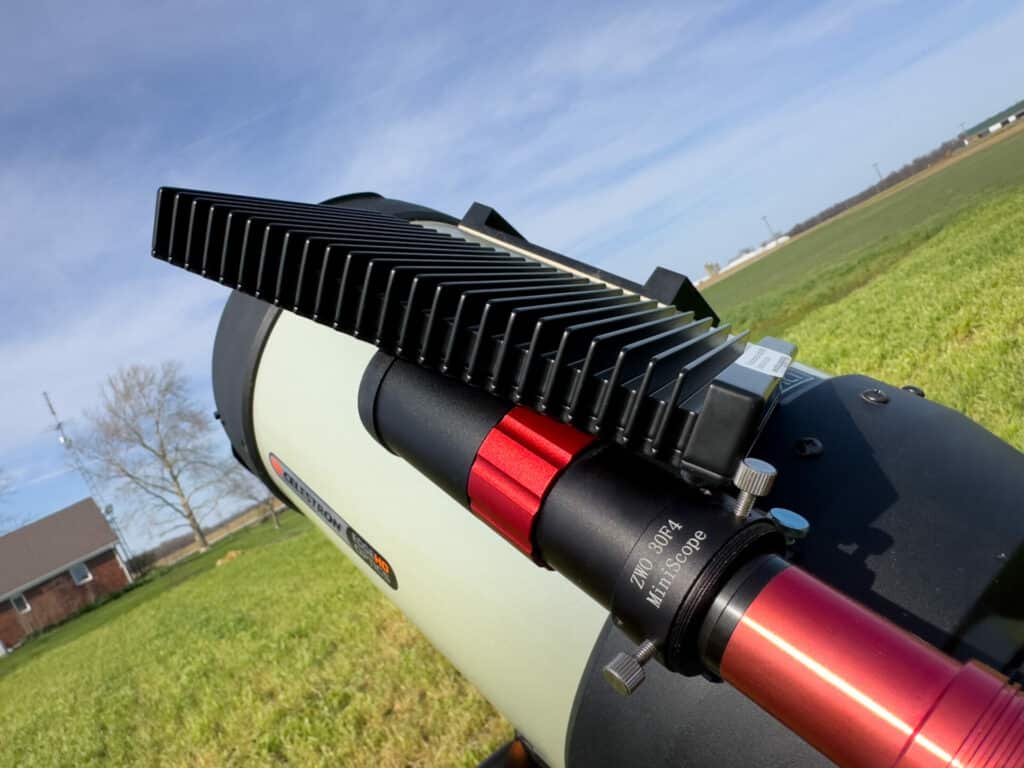
In addition, the ThunderBlade supports a wide range of RAID configurations, including RAID 0 for maximum performance, RAID 1 and RAID 10 for data mirroring, RAID 4 and RAID 5 for a balance of speed and redundancy. This versatility allows users to tailor the storage device to their needs, whether prioritizing speed, data protection, or a combination of both.
Regarding connectivity, the ThunderBlade is equipped with a host port and an additional Thunderbolt 3 (USB-C) port, capable of up to 40 Gb/s (5000 MB/s) data transfer rates. This not only facilitates rapid data movements but also enables daisy-chaining of multiple devices or the addition of a high-resolution display.
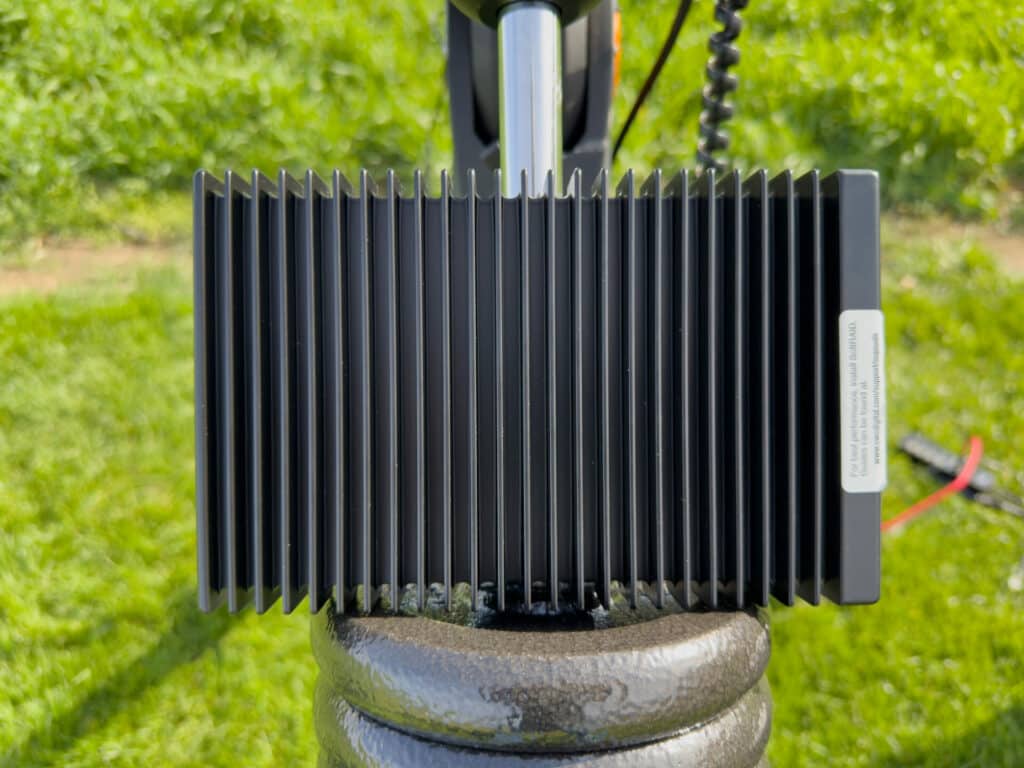
Speaking of displays, the ThunderBlade supports up to a single 5K display at 60Hz or a 4K display at 60Hz, allowing for a detailed visual workspace.
The OWC ThunderBlade also comes in an 8-bay model, ThunderBlade X8. While both offer the same maximum storage capacity, the ThunderBlade X8 holds twice the number of drives, which allows for smaller individual drives (8 x 4TB). It also has a slightly better performance profile, particularly in RAID 5 configurations, with read speeds of 2565MB/s compared to the 4-bay’s 2389MB/s. Additionally, the ThunderBlade X8 provides more usable capacity in RAID 5 due to the distribution across more drives, offering 28TB with redundancy compared to the 24TB of the 4-bay unit. Thunderblade X8 tops out at 2949 MB/s RAID 0, whereas non-X8 Thunderblade tops out at 2840 MB/s RAID 0. The ThunderBlade X8 features an enhanced power connector and reduced LED visibility to minimize distractions during use. Nonetheless, both models offer tremendous power in a small form factor.
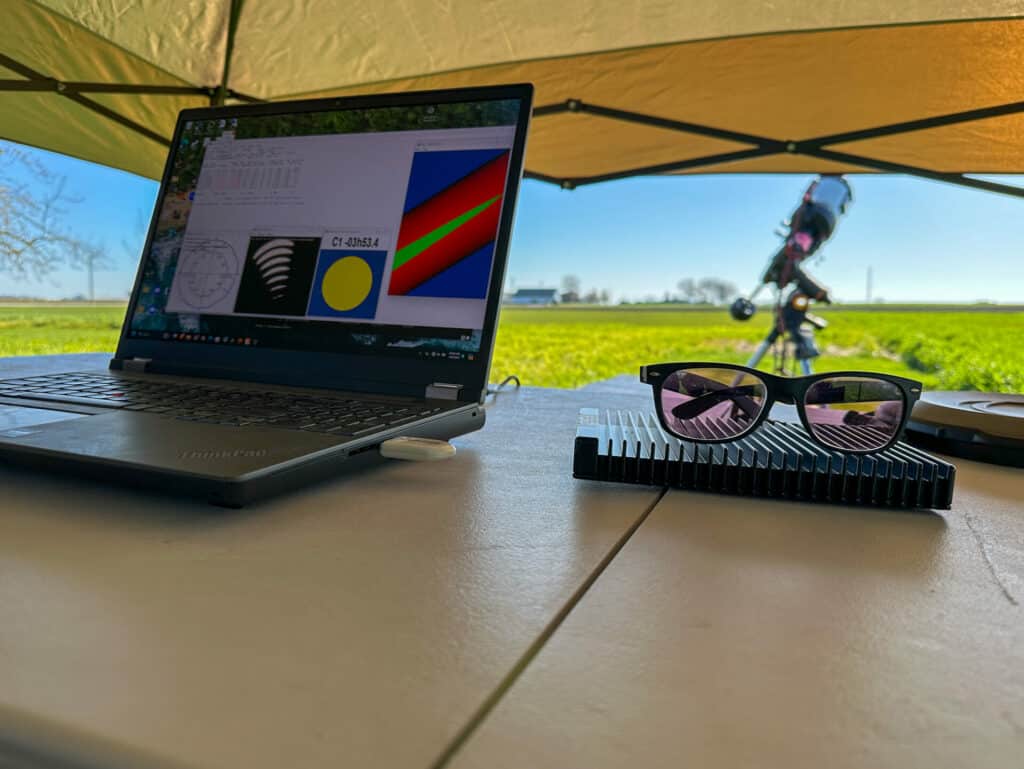
This power is complemented by SoftRAID, an advanced RAID management software that allows users to configure their drives to maximize performance and data security easily. SoftRAID provides a wide range of RAID configuration options. For our project, we focused on RAID 5, but RAID 0, RAID 1, RAID 4, and RAID 5 are also options.
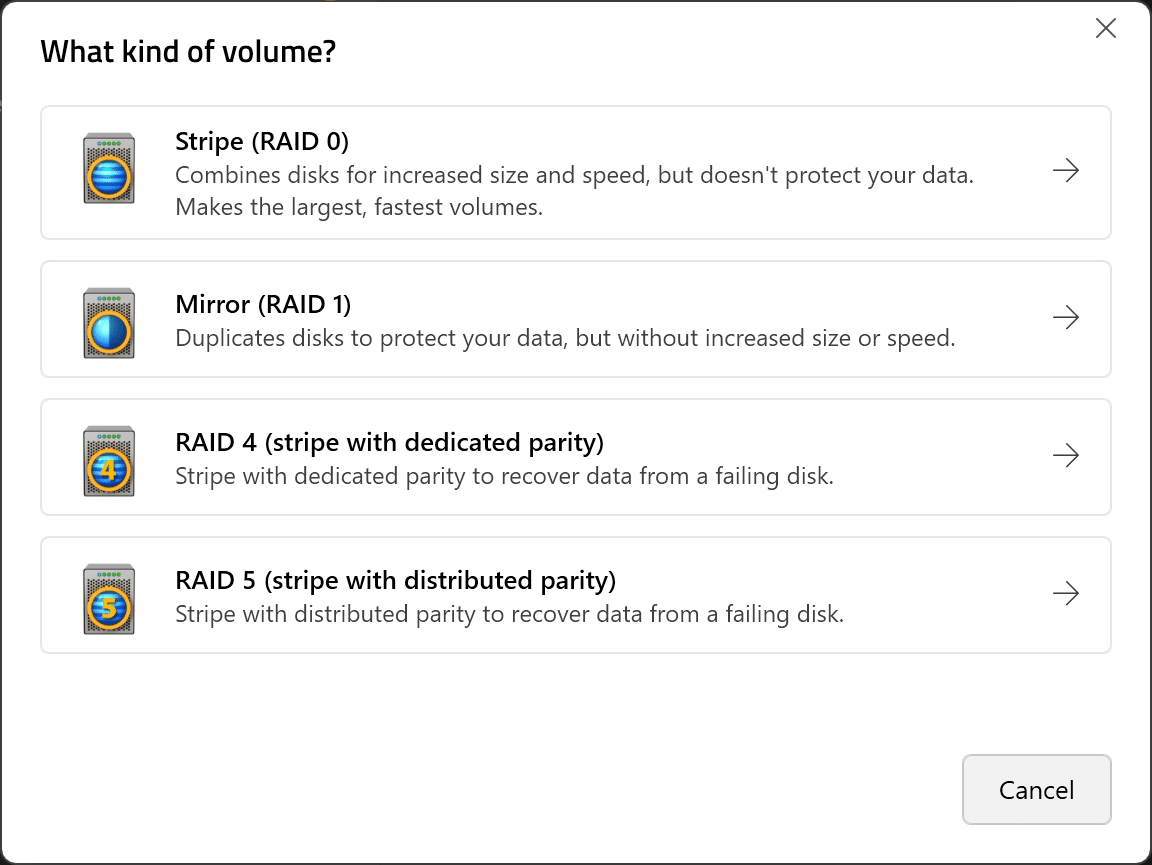
After selecting the RAID type, you can also optimize the volume settings to match your application best.
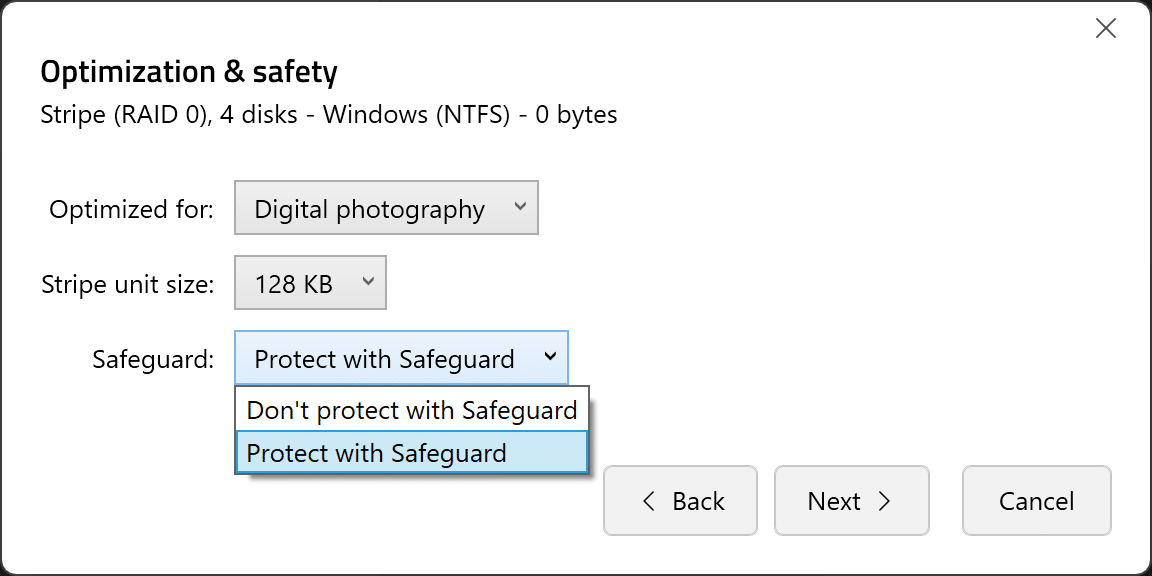
We measured strong performance from the 4-drive ThunderBlade to our eclipse recording platform over Thunderbolt. We measured both RAID 0 and RAID 5 performance, opting for the resiliency from RAID 5 for the final data capture day. For situations where ingesting data at the fastest rates possible is the requirement, RAID 0 may be a better fit.
We leveraged CrystalDiskMark on our host system with a 1GB test file size. At its peak, we measured 2.9GB/s read and 2.2GB/s write in sequential bandwidth over RAID0. In RAID5, those speeds are tapered down to just under 2GB/s read and 600MB/s write. In terms of the lower 4K performance in RAID5, the strip size of the volume wasn’t optimal for the 4K transfer size. Since this volume was created for a photography use case, we selected a 128K stripe size. For workloads that need better 4K transfer speeds, selecting a smaller stripe size for the volume would improve performance.
| Configuration | Test Type | Read (MB/s or IOPS) | Write (MB/s or IOPS) | Mix (MB/s or IOPS) |
|---|---|---|---|---|
| RAID 0 | SEQ1M Q8T1 | 2884.98 MB/s | 2233.22 MB/s | 2686.60 MB/s |
| RND4K Q32T16 | 2236.22 MB/s | 2062.90 MB/s | 1904.60 MB/s | |
| RND4K (IOPS) | 545951.17 IOPS | 503638.67 IOPS | 464989.75 IOPS | |
| RND4K (µs) | 906.95 µs | 997.65 µs | 1069.89 µs | |
| RAID 5 | SEQ1M Q8T1 | 1958.84 MB/s | 593.71 MB/s | 954.52 MB/s |
| RND4K Q32T16 | 37.19 MB/s | 2.61 MB/s | 7.65 MB/s | |
| RND4K (IOPS) | 9078.86 IOPS | 636.96 IOPS | 1867.92 IOPS | |
| RND4K (µs) | 55914.75 µs | 394415.75 µs | 127034.15 µs |
Celestron EdgeHD8
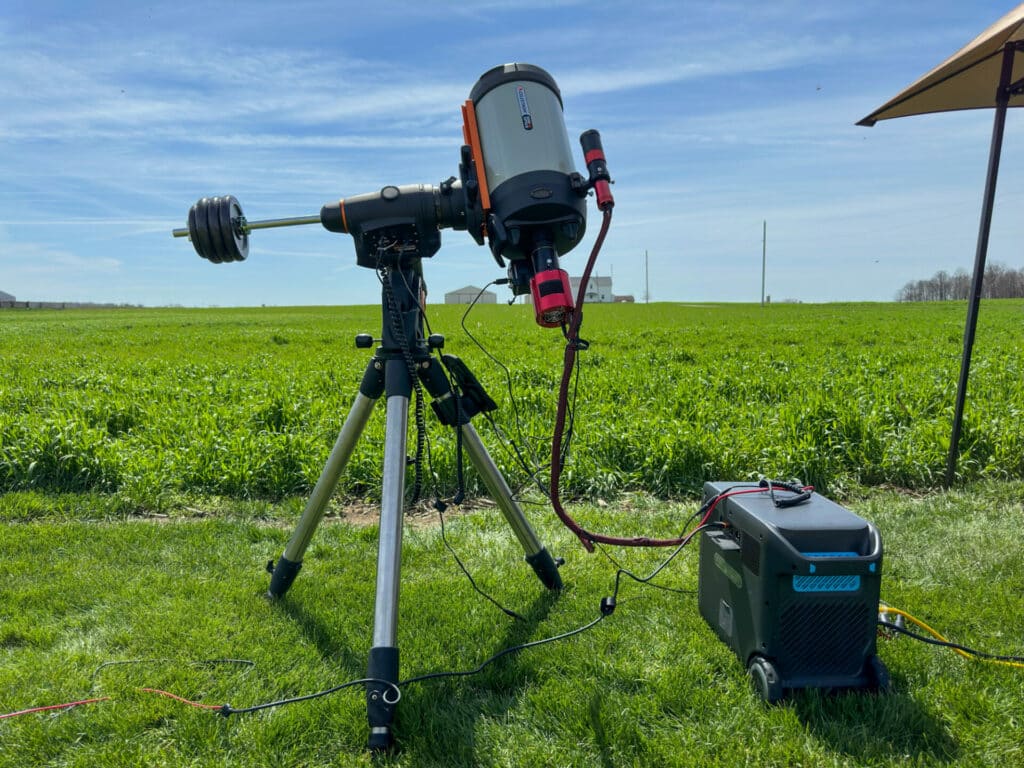
The Celestron EdgeHD8, known for its superior edge-to-edge clarity, serves as the optical component of this project. Traditionally, we have used the 11-inch model with a Hyperstar to achieve a 540mm focal length to capture deep-sky objects, but due to the size of the Moon and sun in the sky, we elected to go with the 8″ model and a .67x reducer. This was calculated to achieve a full-frame image at a 1360mm focal length.
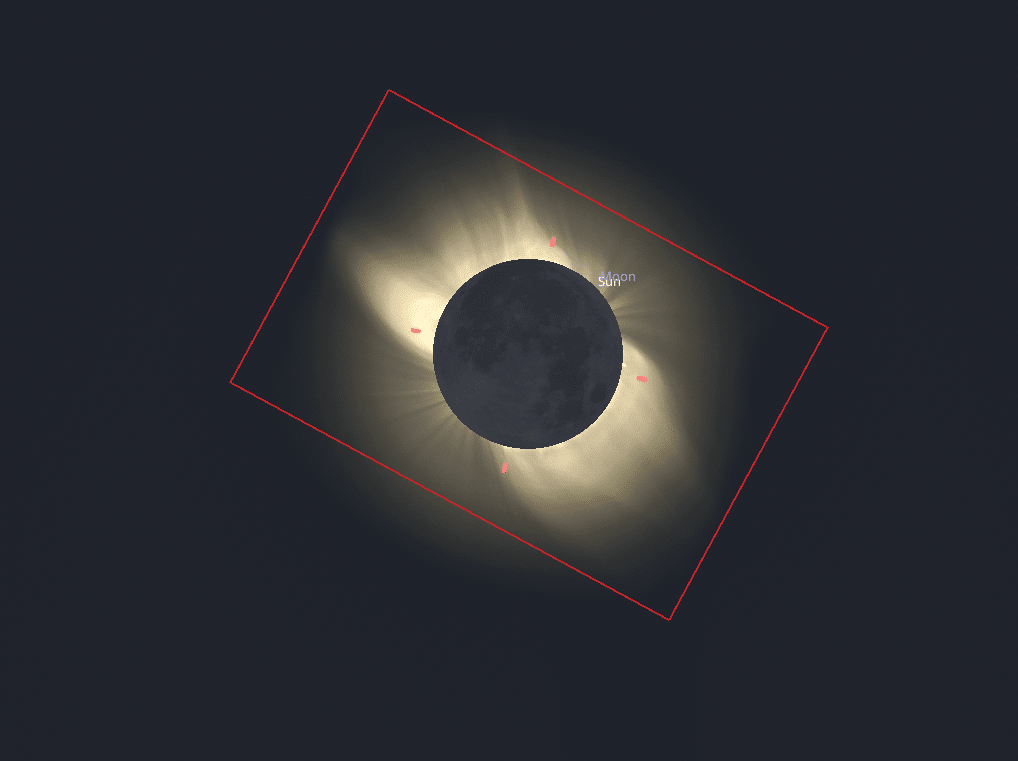
Red box is the predicted framing for the eclipse.
We mounted the whole kit on the Celestron CGEM German Equatorial Mount to provide the stability and precision needed to track the sun’s journey across the sky.
Dedicated Camera
The visual symphony is captured through the ZWO ASI 6200MC Pro 62-megapixel camera. Its high-resolution sensor is pivotal in capturing the eclipse in unprecedented detail, ensuring that every plasma stream and sunspot is visible.
The ZWO ASI 6200MC Pro is an astrophotography camera that excels in capturing celestial events, making it an ideal choice for photographing the 2024 solar eclipse. This camera is renowned for its full-frame color CMOS sensor, the Sony IMX455, which boasts an impressive resolution of 61 megapixels. This high-resolution sensor is particularly beneficial for capturing the intricate details of the solar corona and the dramatic phenomena of Baily’s beads during an eclipse. Its ability to record vast amounts of detail not only enhances the visual impact of images but also provides a rich data source for scientific analysis.
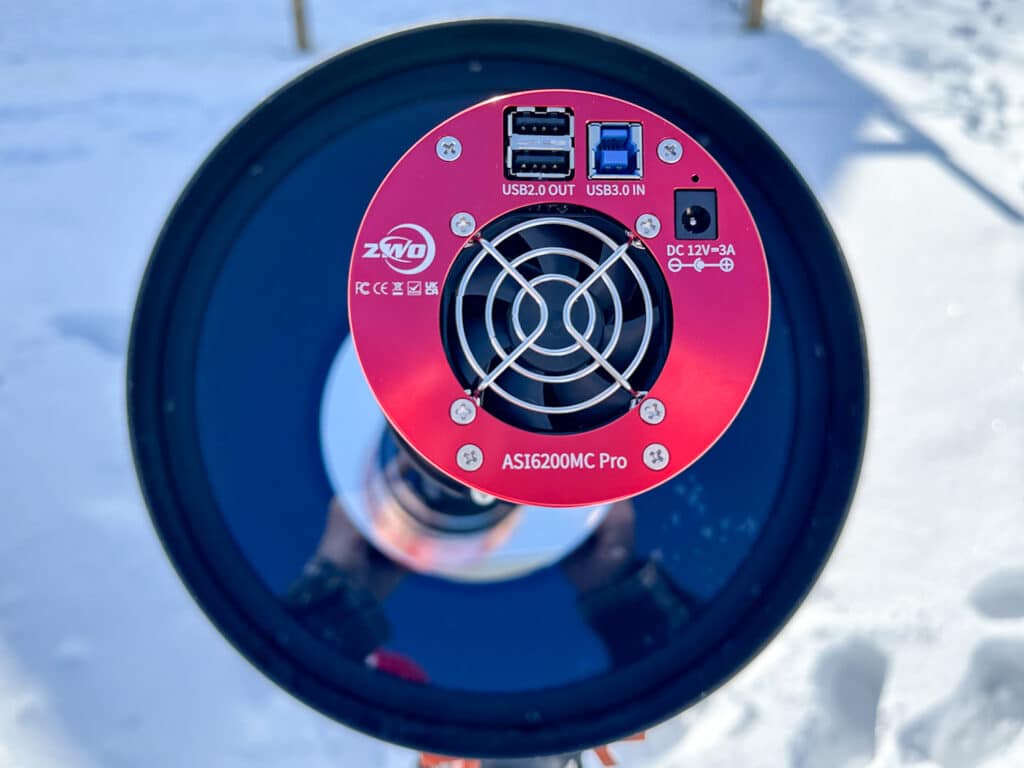
One of the most essential features of the ASI 6200MC Pro is its extensive dynamic range, which ensures that the eclipse’s brightest and darkest parts can be captured with minimal risk of over or underexposure. This is crucial for eclipse photography, where the lighting conditions change drastically and rapidly. Additionally, the camera’s thermoelectric cooling system significantly reduces noise, a critical factor when dealing with the high-contrast environments typical of solar eclipses.
This 6200 MC Pro has a high-speed USB 3.0 interface, which facilitates fast data transfer—essential for capturing the transient phases of an eclipse in high resolution and fast frame rates. These features, combined with its robust build and ease of integration with popular astronomy software, make the ZWO ASI 6200MC Pro a top-tier tool for amateur astronomers and seasoned astrophotographers looking to document the 2024 solar eclipse.
Conclusion
The synchronization of advanced software with robust hardware creates a symphony of technology that allows us to capture and share moments of cosmic significance. This eclipse event is not just a celestial phenomenon but a testament to human ingenuity and the relentless pursuit of perfection in the digital age.
The OWC ThunderBlade proved to be a pivotal component in our tech arsenal. Its speed and reliability ensured that every nuanced eclipse detail was captured and preserved with remarkable fidelity. This was not merely about collecting data but seizing a once-in-a-lifetime event with the utmost precision and data protection.
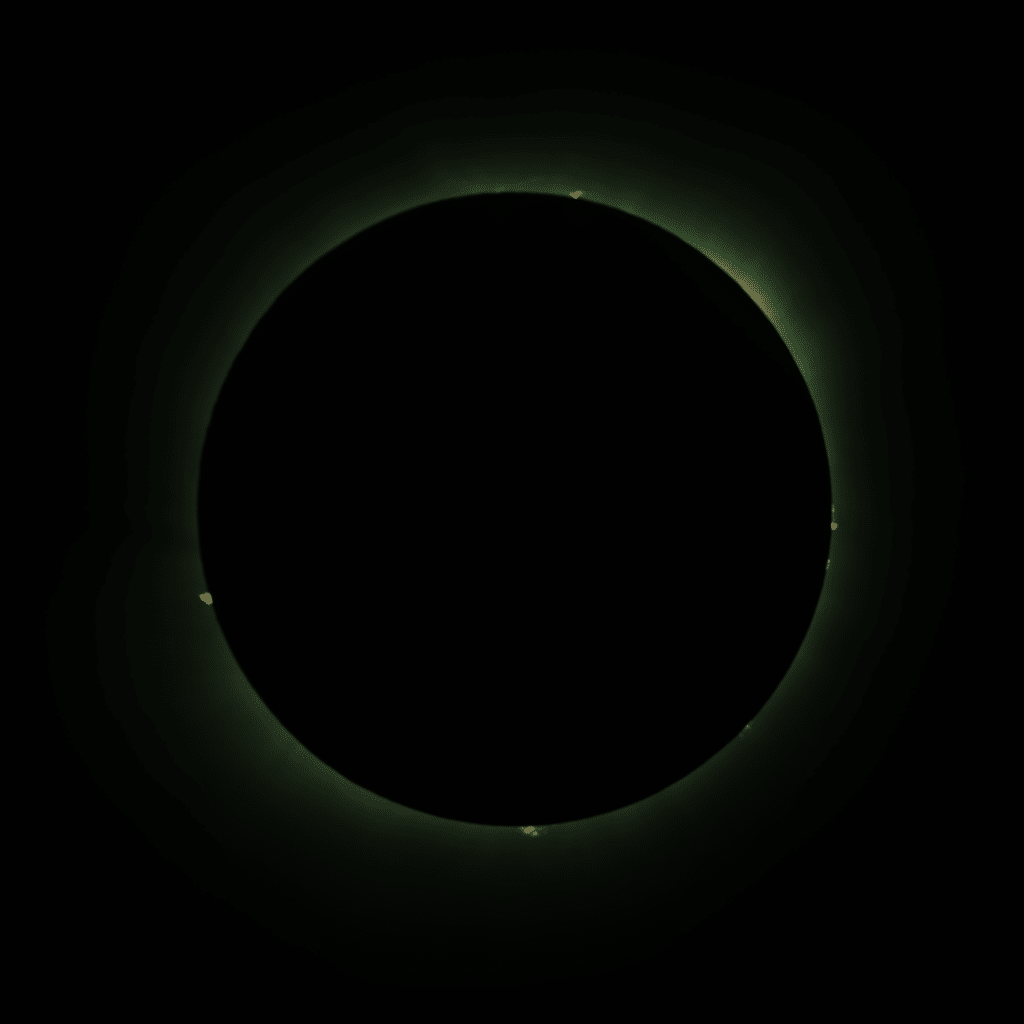
The integration of the OWC ThunderBlade was not just a technical choice but a strategic one. Its robust data handling capacities and the flexibility of RAID configurations allow us to capture and protect the critical data of this astronomical event. The ability to rapidly process and store vast amounts of data means that every second of the eclipse is utilized to its full potential, leaving no detail to chance.
The entire system’s performance, from the Eclipse Orchestrator’s strategic calculations to the dynamic imaging capabilities of the ZWO ASI 6200MC Pro camera feeding into the ThunderBlade, showcases a symphony of advanced technology working in seamless concert.
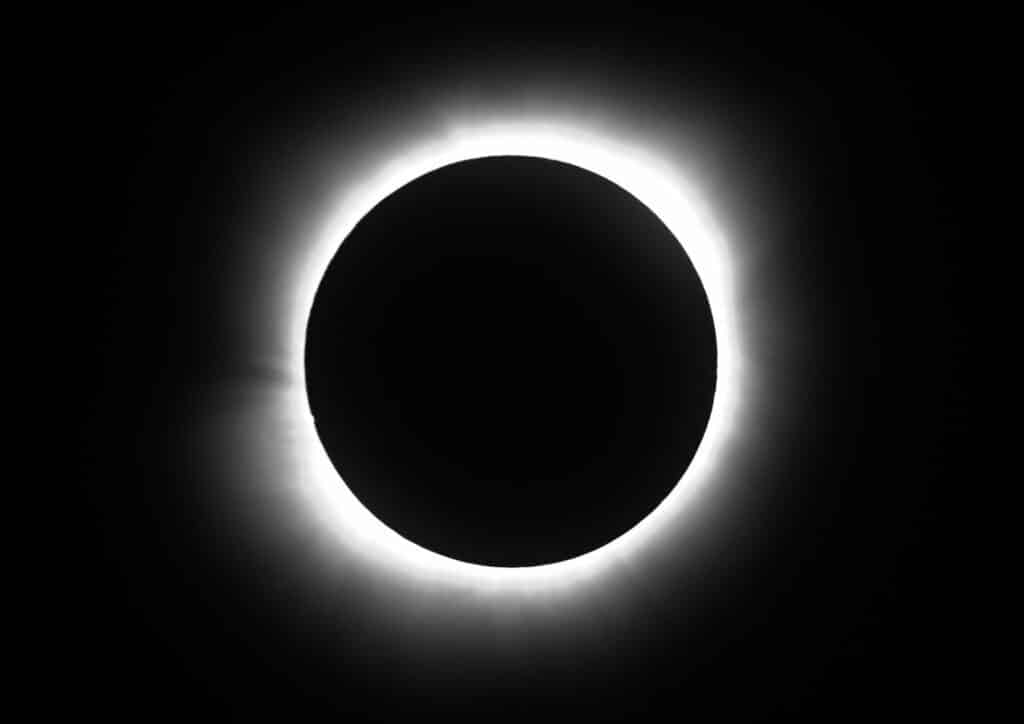
Taking too much gear to the remote farm proved well worth the effort. Outside of a few key components and the weather, little could disrupt the event for us. Thankfully, the clouds parted, and we were treated to an absolutely stunning view of the eclipse. The ShaprCap sequence script worked as intended, and we captured loads of raw data that will be available publicly for processing.




 Amazon
Amazon